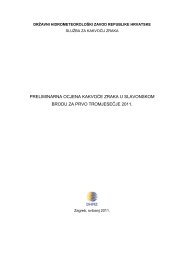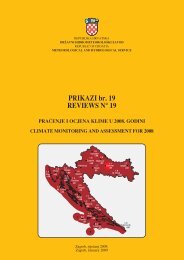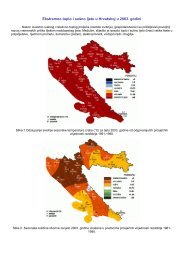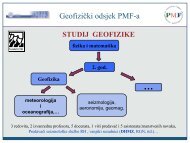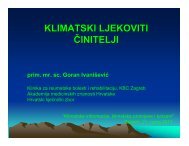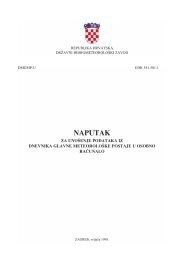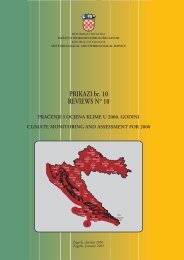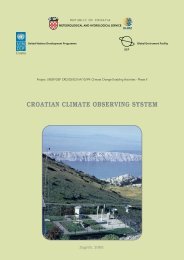Observed climate changes in Croatia Climate change scenario
Observed climate changes in Croatia Climate change scenario
Observed climate changes in Croatia Climate change scenario
Create successful ePaper yourself
Turn your PDF publications into a flip-book with our unique Google optimized e-Paper software.
objective statistical method. Interannual variations of some meteorological parameters with<strong>in</strong><br />
selected periods have been compared from which it can be concluded on the <strong>change</strong> of<br />
variability <strong>in</strong> future <strong>climate</strong> <strong>in</strong> relation to the present one.<br />
In all seasons, RegCM predicts temperature <strong>in</strong>crease with<strong>in</strong> the entire <strong>in</strong>tegration<br />
doma<strong>in</strong>, as well as throughout the depth of the model atmosphere. In the cold part of the year,<br />
the warm<strong>in</strong>g will be slightly <strong>in</strong>creased <strong>in</strong> the northern (cont<strong>in</strong>ental) <strong>Croatia</strong>, while <strong>in</strong> warm periods<br />
the warm<strong>in</strong>g will be <strong>in</strong>creased <strong>in</strong> the littoral <strong>Croatia</strong>. Warm<strong>in</strong>g <strong>in</strong> RegCM <strong>in</strong>tegrations is <strong>in</strong><br />
agreement with warm<strong>in</strong>g <strong>in</strong> EH5OM global model, whose data were used to force RegCM via<br />
<strong>in</strong>itial and boundary conditions; however, the amplitude of the warm<strong>in</strong>g is generally a little lower<br />
<strong>in</strong> RegCM, than <strong>in</strong> EH5OM model.<br />
The decrease of total precipitation <strong>in</strong> future <strong>climate</strong> is expected <strong>in</strong> a large part of the year,<br />
primarily <strong>in</strong> the littoral <strong>Croatia</strong> and its h<strong>in</strong>terland. Such a decrease is, <strong>in</strong> relative terms, highest <strong>in</strong><br />
summer because of pronounced climatological m<strong>in</strong>imum <strong>in</strong> the annual cycle for total<br />
precipitation <strong>in</strong> this part of <strong>Croatia</strong>. In w<strong>in</strong>ter there will be a slight <strong>in</strong>crease of precipitation, aga<strong>in</strong><br />
<strong>in</strong> a narrow littoral zone, but such an <strong>in</strong>crease is not statistically significant. In the northern<br />
<strong>Croatia</strong> no significant precipitation <strong>change</strong> <strong>in</strong> future <strong>climate</strong> is expected.<br />
Analysis of the modelled number of days for some significant and extreme events<br />
(number of days with snow, hot days and days with precipitation larger than 10 mm) for the 20 th<br />
century <strong>climate</strong> broadly matches observational data, although not <strong>in</strong> all details. The largest<br />
differences between the model and the observations could be attributed to <strong>in</strong>adequate<br />
orography representation regardless of the fact that regional model has relatively f<strong>in</strong>e horizontal<br />
resolution. Future <strong><strong>change</strong>s</strong> <strong>in</strong>dicate a decrease <strong>in</strong> the average number of days with snow, an<br />
<strong>in</strong>crease <strong>in</strong> the number of hot days, as well as slight <strong>in</strong>crease <strong>in</strong> the number of days with<br />
significant precipitation <strong>in</strong> w<strong>in</strong>ter. This statistics agrees well with <strong>climate</strong> <strong>change</strong> of the mean<br />
values for near-surface temperature and total precipitation.<br />
References:<br />
Branković Č., Srnec L., Patarčić M. (2009): An assessment of global and regional <strong>climate</strong> <strong>change</strong> based<br />
on the EH5OM <strong>climate</strong> model ensemble. Climatic Change (u tisku, DOI 10.1007/s10584-009-<br />
9731-y).<br />
Dick<strong>in</strong>son, R.E., Errico R.M., Giorgi F. i Bates G.T. (1989): A regional <strong>climate</strong> model for the western<br />
United States. Climatic Change, 15, 383-422.<br />
Fritsch, J.M. i Chappel C.F. (1980): Numerical prediction of convectively driven mesoscale pressure<br />
systems. Part I: Convective parameterization. Journal of the Atmospheric Sciences, 37, 1722-<br />
1733.<br />
Giorgi, F. (1990): Simulation of regional <strong>climate</strong> us<strong>in</strong>g a limited area model nested <strong>in</strong> a general circulation<br />
model. Journal of <strong>Climate</strong>, 3, 941-963.<br />
28



